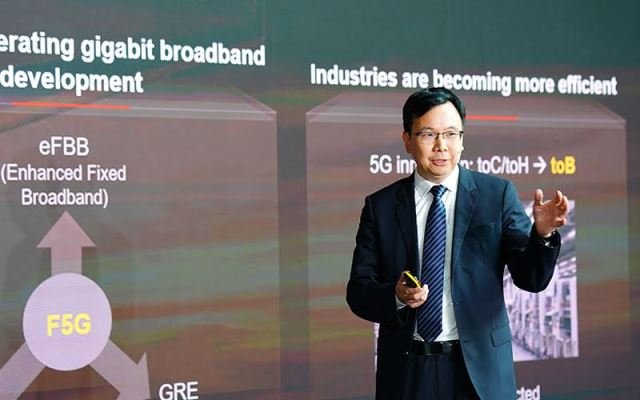
The era of 5.5G is imminent, driven by the need for stronger networks that can support innovative services across business and customer segments, says Chaobin Yang, Senior Vice President and President of ICT Products & Solutions at Huawei.
Delivering a keynote titled, “On the Fast Track to the 5.5G Era,” at MWC 2023, Barcelona, Chaobin Yang said that 5.5G is necessary to improve 5G, which has become an industry trend and an established consensus. The industry is on fast-track to adopt 5.5 standards as well. The 3GPP Release 18 for 5.5G and the ETSI F5.5G Release 3 are getting ready to be frozen in 2024 H1.
The innovations brought by 5G have led to major transformation in 2B segment. Worldwide, 5G has acquired over 1 billion users, comprising 100 million gigabit broadband users and facilitating over 20,000 different industry applications. F5G is accelerating gigabit broadband development with three key features eFBB (enhanced Fixed Broadband), FFC (full fiber connection) and GRE (Guaranteed Reliable Experience). Now, 5.5G is set to bring operators a 10-fold increase in network performance over 5G, Chaobin Yang added.
Chaobin Yang presented that with 5.5G, the peak rates experienced by mobile and home broadband users will increase from 1 Gbit/s to 10 Gbit/s, ensuring better experiences in immersive and interactive services. Passive IoT technology enables an increase in the number of connected things from 10 billion to 100 billion. Hailed as the Net 5.5G era, this period will be dominated by technologies like Cloud, AR/VR, AI, big data and Edge computing.
In the consumer segment, for example, 5G HD video streaming was a normal in 2022, but by 2025 we are heading to the Internet of People era powered by 3D applications such as 3D online malls, 24K VR gaming, and glasses-free 3D video. While HD video streaming was capable at 1 Gbps, the new immersive applications demand 10X speed and greater network efficiency.
Similarly, in the business segment, Internet of Things (IoT) is evolving from Low-Power Wide-Area (LPWA) to passive IoT that extends mobile connectivity from high-speed active solutions to ultra-low-speed passive ones. Passive IoT tags can transmit data, and can also be used for positioning and on temperature sensors. Such tags can be used in a wide variety of scenarios, such as automated inventory of warehouse items, agriculture and livestock development, and positioning of personal items. Currently, more than 30 billion passive IoT tags (based on technologies like RFID) are consumed a year. As more industries go digital, the number of passive IoT tags used every year is expected to reach 100 billion, Chaobin Yang said.
Next, 5.5G networks with the sensing capability can be used extensively in scenarios like smart city road traffic services and perimeter sensing, making urban infrastructure more efficient and intelligent. For example, in rainy or foggy weather, 5.5G networks can automatically detect obstacles or abnormalities on the road and notify drivers through the maps in their cars one kilometer in advance, making transportation safer.
Industry digitization is driving the demand for greater uplink bandwidth across many applications. From 5G + cameras to visual intelligent inspection and to 3D visual intelligent inspection, the demand for uplink bandwidth is rapidly increasing. Fiber connections are extending from homes and enterprises to production lines and even production equipment.
By 2030, enterprises will increasingly turn to application-driven architecture in cloud. The cloud applications will need real-time, reliable, and easily-accessible connectivity, bringing new opportunities to transmission networks, whether they are between edge cloud nodes, between edge cloud nodes and central clouds, or between enterprises and the cloud. The interconnected clouds and the data centers that form the WAN fabric will demand extensive storage and computing resources. Thus future networks will be characterized by intelligent self-monitoring and self-reporting capabilities.
To progress towards this world of opportunities and ensure maximum return from their 5G investments, evolving to 5.5G can help protect operator investment, Chaobin Yang said. With the integration of the existing mmWave, U6G spectrum bands, spectrum refarming and equipment multimode multiplexing, the evolution to 5.5G will be smoother. A major milestone in this regard was achieved back in June when 3GPP completed the upper 6 GHz licensed band specification for 5G.
Meanwhile, 5.5G will push the boundaries of fixed networks with 50G PON, compared to the 10G PON with 5G. F5.5G marks an era of ultra-broadband, Chaobin Yang said while adding that commercial deployment of 50G PON is expected by 2025. 50G PON standards were released in 2021 with other key specifications like latency of 2micro seconds and 2H/2B network slicing. The transition is smooth and cost-effective. The major takeaway is that since the ODN remains unchanged, the migration yields maximum ROI. In fact, the ODN costs nearly 80% of the FTTX costs. The technology is also backward compatible with G/10G.
However, to make 5.5G a faster reality, consensus on technologies is required for Net 5.5G, Chaobin Yang added. In July 2022, Huawei released its vision of “Innovation, Lighting up the 5.5G Era”. At this year’s MWC, together with operators and industry partners around the world, Huawei will explore innovative services and new business opportunities of the approaching 5.5G era.
